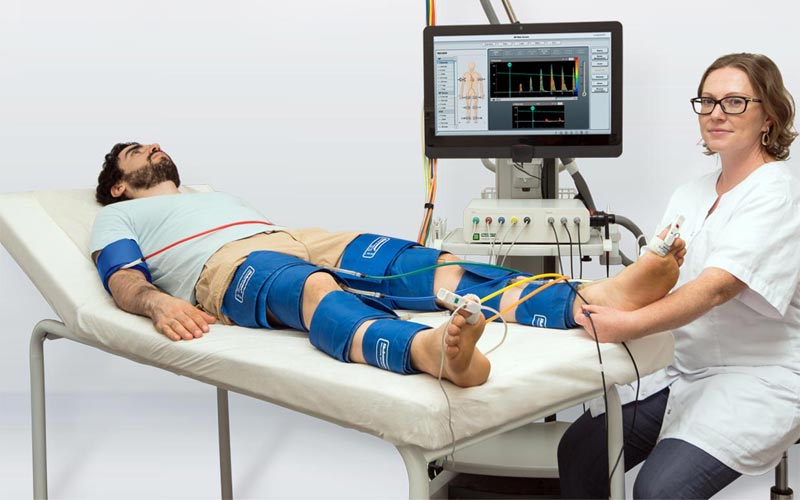Peripheral Vascular Diagnostics for PAD: ABI, PVR & Doppler in Early Detection
13 October 2025
MedTech Edge provides leading peripheral vascular diagnostics in Australia & New Zealand, offering ABI, PVR & Doppler systems for early PAD detection.
Understanding Peripheral Artery Disease (PAD)
Peripheral Artery Disease (PAD) occurs when plaque builds up in the arteries supplying the legs, leading to reduced blood flow and increased cardiovascular risk. This condition is common among older adults but also affects individuals with specific lifestyle and health-related factors. Early warning signs include leg pain during walking, slow-healing wounds on the feet, or numbness and coldness in the lower limbs. Identifying these symptoms early ensures timely referral for further vascular evaluation.
Why Peripheral Vascular Diagnostics Are Essential for PAD Screening
Early diagnosis of PAD depends on reliable vascular testing, which provides clinicians with measurable data beyond physical examination alone. Delayed detection often results in advanced disease requiring surgical intervention, whereas timely screening helps guide conservative treatment strategies. These methods allow practitioners to monitor disease progression and tailor management plans, ultimately reducing the risk of severe complications such as amputation or cardiovascular events.
The value of non-invasive testing in PAD is supported by evidence. The study “Noninvasive physiologic vascular studies: A guide to diagnosing peripheral arterial disease” highlights how physiologic vascular studies such as ABI, Doppler waveforms, and PVR offer reliable insights into arterial function and disease progression (Sibley et al., 2017).
Ankle-Brachial Index (ABI): The First Step in PAD Detection
ABI is one of the simplest yet most effective tools in peripheral vascular diagnostics. It compares blood pressure measurements taken at the ankle with those in the arm, providing a reliable indicator of arterial obstruction. Abnormal readings highlight impaired blood flow and support early referral for further imaging.
The main advantages of ABI testing are:
• Non-invasive – Conducted using standard blood pressure cuffs and Doppler probes, with no patient discomfort.
• Quick and efficient – Results are available within minutes, making it suitable for routine screening.
• Reliable baseline tool – Detects early changes in circulation before symptoms escalate.
• Cost-effective – A low-cost method that provides high clinical value in primary care and specialist settings.
Pulse Volume Recording (PVR): Assessing Blood Flow Patterns
PVR testing complements ABI by analysing volume changes in the limb during the cardiac cycle. This approach evaluates the quality of blood flow through waveform interpretation, highlighting arterial narrowing or occlusion. When combined with ABI, PVR enhances diagnostic accuracy, offering clinicians a broader understanding of circulatory health in the lower extremities.
Doppler Ultrasound: Visualising Arterial Blockages
Doppler ultrasound adds a real-time imaging dimension to peripheral vascular diagnostics. Using sound waves to map arterial flow enables clinicians to detect narrowing or blockages with precision. Unlike pressure-based tests, Doppler provides direct visual evidence of the severity and location of disease.
The primary benefits include:
• Real-time imaging – Offers immediate insights into arterial conditions.
• Detailed localisation – Pinpoints the exact site of narrowing or blockage.
• Non-invasive and safe – No radiation or invasive procedure required.
• Supports treatment planning – Informs whether surgical or non-surgical intervention is required.
• Effective for follow-up – Tracks changes in arterial health after treatment or lifestyle modification.
MedTech Edge: Advancing Vascular Care
Accurate PAD screening through ABI, PVR, and Doppler ultrasound enables earlier intervention, reducing complications and improving patient outcomes. At MedTech Edge, we provide advanced peripheral vascular diagnostics with Falcon systems that are comprehensive, adaptable, and designed for diverse clinical needs. Our ultramodern non-invasive technologies make vascular screening precise, scalable, and clinically reliable.
Contact us today to enhance your diagnostic service.
Related Blog Article: Pulse Volume Recording (PVR): Improve Non-Invasive PAD Diagnosis with the Falcon
Optimized by: Netwizard SEO





